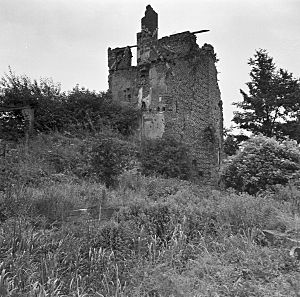Battle of Broekhuizen facts for kids
Quick facts for kids Battle of Broekhuizen |
|||||||
|---|---|---|---|---|---|---|---|
| Part of the Western Front of World War II | |||||||
|
|||||||
| Belligerents | |||||||
| Strength | |||||||
| 300 | 200 | ||||||
| Casualties and losses | |||||||
| 43 killed 140 wounded |
17-60 killed 139 captured |
||||||
The Battle of Broekhuizen was a tough fight during World War II. It happened in November 1944 in a small Dutch village called Broekhuizen. This village is located near the Meuse River. The battle was part of a bigger plan by the Allies to free the western side of the Meuse River in the Netherlands. Even though it was a small battle, it was very difficult and many soldiers were hurt.
Contents
Why Was Broekhuizen Important?
In late November 1944, German soldiers had turned Broekhuizen into a strong defensive position. It was one of the few places they still held on the west side of the Meuse River. British soldiers from the 15th (Scottish) Infantry Division first surrounded the village.
The Germans had made the village like a fortress. They hid in houses and cellars. They also used the village's old castle, called the Kasteel. This castle was a medieval manor house with thick walls and a moat (a water-filled ditch). They built many trenches and laid out a large minefield. German artillery (big guns) on the other side of the river also supported them.
The Battle Begins
On the night of November 27, Scottish soldiers from the 9th Cameronians attacked the Kasteel. German paratroopers from Fallschirmjäger-Regiment 20 were defending it. The British soldiers did not realize how strong the German defenses were. Their attack failed, and more than half of the attackers were killed, wounded, or captured.
The next day, November 28, the Scottish soldiers were replaced. New British soldiers from the 3rd Battalion of the Monmouthshire Regiment arrived. They were part of the 11th Armoured Division (United Kingdom).
The Main Attack
At dawn on November 30, the 3rd Monmouths launched a new attack. They planned to attack both the Kasteel and the village of Broekhuizen. They had to cross open ground from nearby woods.
The British soldiers faced many dangers. They had to get through the minefield. German machine guns fired heavily from the Kasteel. Mortars and shells also rained down from across the Meuse River.
The 3rd Monmouths had help. They had artillery support and thirty tanks from the 15th/19th The King's Royal Hussars. They also had twelve special "Mine flail" tanks. These tanks, from the Westminster Dragoons, had chains that spun around to clear mines.
The Hussars' tanks fired at German positions from the woods. The Dragoons' flail tanks cleared a path through the minefield. The Monmouths followed behind them.
A Difficult Fight
The attack was very tough. The Germans were dug in very well. The Monmouths suffered terrible losses, especially after the flail tanks moved past them. Another group of soldiers, D Company, had to join the fight to help take the village.
The leader of the 3rd Monmouths, Lieutenant-Colonel Stockley, was killed while leading the attack on the Kasteel. Colonel Taylor, the leader of the Hussars, then took charge.
To break the deadlock, the Hussars' tanks moved closer. They fired powerful explosive shells at the Kasteel walls. This helped D Company reach the village. They fought house-to-house and managed to clear it with fewer casualties.
By dusk, the Kasteel and the village were badly damaged. The remaining German soldiers surrendered a few days later. The 3rd Monmouths, who had suffered many casualties, were then replaced by the 4th King's Shropshire Light Infantry. The Monmouths were taken out of the fighting until December 17 to rest and get new soldiers.
What Happened After?
The British won the battle, but it came at a high price. The 3rd Monmouths' A and C Companies lost 70% of their soldiers. Out of 300 British soldiers, 43 were killed and 140 were wounded.
On the German side, 139 soldiers were captured. Many other German soldiers managed to escape across the Meuse River. Estimates say between 17 and 60 German soldiers were killed.
Remembering the Battle
A war memorial stands at Broekhuizen. It is on the north wall of the Sint Nicolaaskerk churchyard. It was unveiled 50 years after the battle. The memorial lists 42 British soldiers who died between November 27 and 30, 1944. Eleven names are from the 15th Scottish Division, and 31 are from the 11th Armoured Division.
During the battle, one of the Westminster Dragoons' flail tanks was hit and destroyed. This tank is now on display at the Overloon War Museum.



